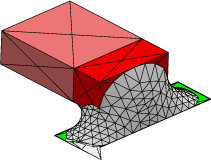Tombstone example home page
Next tombstone page
Previous tombstone page
Tombstone Example tomb-D for the
Surface Evolver
[Click for the tomb-D.fe datafile in a second window.]
This model permits the liquid solder to wet the sides of the chip.
 |
 |
 |
| Starting geometry. |
Evolved with gogo. |
Evolved further, showing problems. |
Notable features:
- The solder is still completely enclosed with facets, so the contact
angles are all implemented by setting the surface tensions of facets.
- The problems due to the explosive nature of negative tension facets
are getting serious here. Evolution in
gogo had to be stopped before
the surface got close to equilibrium.
- The solder contact facets on the sides of the chip do not have
all possible one-sided constraints on them, to speed calculations.
This means special steps are needed in deleting edges, since the
Evolver will only delete edges when the constraints on the edge
match the constraints on one of its endpoints. So a special edge
deleting command
deledge is defined that removes one-sided constraints
from the edge endpoints before deleting the edge. The command is
used by setting the variable deledge_id to the id number of the
edge to be deleted, and calling deledge.
- Note how the contact line dips to a cusp along the vertical front
edges of the chip. Since the sum of the contact angles on either side
of such an edge is less than 90 degrees, the contact lines will ideally
become tangent to the edge, or else reach all the way down to the chip
bottom.
-
Also note how the contact line cusps along the bottom edge of the chip
on the side. Such cusping requires careful evolution, particularly
when the contact surfaces are explicitly represented with facets.
Tombstone example home page
Next tombstone page
Previous tombstone page
Surface Evolver home page
Ken Brakke's home page





